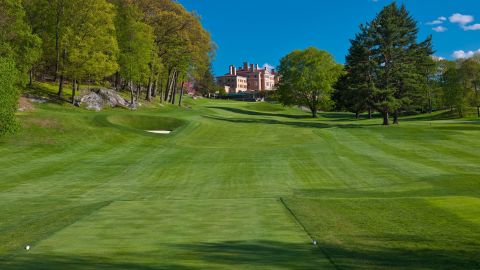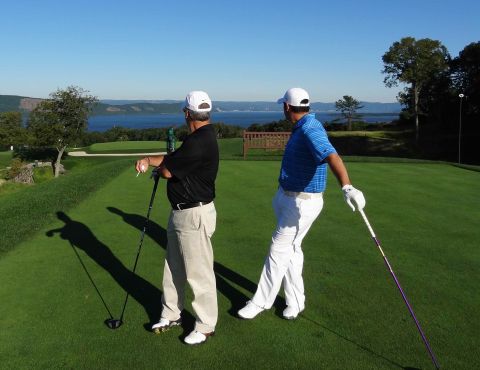Special to Golf Community Reviews: Text & photos by Scott Simpson
Sleepy Hollow Country Club is a justifiably storied name in the history of American golf, amongst a handful of clubs where the game of golf put down its roots in this country. The club’s original membership formed a Who’s Who of American business and society, including William Rockefeller, John Jacob Astor, Cornelius Vanderbilt, Oliver Harriman and Harrison Williams, amongst other prominent personages. Befitting its location, the club took as its logo Washington Irving’s iconic Headless Horseman, though the imagery is perhaps even more appropriate than it initially seems, as headless horsemen also have deep roots in both Scottish and Irish folklore.

The finishing hole at Sleepy Hollow is an uphill Par 4 appropriately named Mansion Rise. This hole was added by Tillinghast, as Macdonald’s original routing stayed on the lower ground of the property. The outdoor space under the green awning is a particularly delightful spot for lunch or a post-round adult beverage.
The 338-acre property in the “Washington Irving” hills was originally purchased by Rockefeller and Frank Vanderlip in 1910, including a 75-room Neo-Renaissance mansion built for but never occupied by Vanderbilt’s granddaughter, and sold in 1911 to the organizers of the club. The newly formed Sleepy Hollow Club retained the services of Charles Blair Macdonald, considered the father of American golf course architecture (in fact, it was Macdonald who coined the term “golf course architect”), to design its course, which opened in 1914. It was Macdonald’s second design commission after the completion of his masterpiece, The National Golf Links of America on Long Island.
I was particularly excited to play Sleepy Hollow as my golf travel plans include an early October return trip to Bandon Dunes to check out Old Macdonald, the recently completed TomDoak/Jim Urbina homage to Macdonald. With hopes to extensively research the man’s work, I spent the summer shamelessly begging all who crossed my path for entrée to The National but, alas, came up empty. Unless a kind-hearted reader of this blog site comes to my rescue, you’ll likely find me in the gallery when the Walker Cup returns to The National in 2013 (the club hosted the inaugural Walker Cup in 1922).
I was fortunate to play Sleepy Hollow as part of the Met Open Pro-Am
Macdonald collaborated on virtually all of his best-known designs with Seth Raynor, an accomplished designer in his own right, and their joint legacy includes, in addition to The National, such notable tracks as The Mid-Ocean Club in Bermuda (specifically built as a refuge from Prohibition), Yale Golf Club, The Greenbrier and the reputedly spectacular but now lost for the ages Lido Golf Club. Macdonald, an American, was sent to live with his Scottish grandfather in St. Andrews as a teenager, before golf had crossed the Atlantic. I expect to have much more to say about Macdonald after our Bandon Dunes trip, covering his unique experiences in St. Andrews (his introduction to the game came via Old Tom Morris), his rather large self-regard, as well as his formative role in promoting the game in the U.S. Amongst his extensive contributions, Macdonald built the first 18-hole golf course in the U.S. (Chicago Golf Club), was a driving force in the establishment of the United States Golf Association and was also a great amateur player, winning the first United States Amateur (his 12 and 11 margin of victory in the championship match is still a record). Macdonald was truly the vanguard of the golden era of golf course architecture, blazing the path followed by Raynor, Mackenzie, Ross, Tillinghast and others.
Macdonald’s stated goal was to bring the design features of the greatest golf holes of Scotland to the U.S., what later came to be known as template holes. Thus his courses feature Alps, Redan, Biarritz and Eden holes, modeled and frequently named after their source influences in Scotland (excepting Biarritz, which is obviously not of Scottish ancestry). These were in no way slavish reproductions of the originals, but rather the designers looked for features of the properties that would facilitate creating similar strategic challenges as the original holes, bearing in mind that this was an era in which the architect did not have the ability to move much earth. We find some notable examples of these at Sleepy Hollow.

The 3rd is Macdonald’s Eden hole at Sleepy Hollow, modeled after the 11th at The Old Course. Macdonald felt that the original’s only weakness was that it could be played from tee to green with only a putter. Played across a deep gorge, only partially visible here, this “Eden” takes putter out of play off the tee.
Macdonald and Rockefeller were both, no surprise, strong personalities and had a falling out even before the course opened for play. Thus, in the late 1920s/early 1930s, the club hired A.W. Tillinghast, the renowned creator of both courses at Winged Foot, Quaker Ridge and Fenway, to add a third nine for the club. He accomplished this through a substantive change in the routing, adding what are now the 1st and 18th holes -- Macdonald’s routing did not start or end at the mansion-clubhouse, probably because of his concerns about steep slope of the land involved -- as well as a corridor of holes, the 8th through12th, that head off into the woods.
This created a unique existential dilemma for the club in developing its master plan: Were they restoring a Macdonald or a Tillinghast? Given that Tillinghast’s work at Sleepy Hollow, excepting perhaps the uphill finishing hole, was likely not his best (unlike at nearby Winged Foot), the logical decision was to emphasize a return to the design concepts of Macdonald, a decision that was agonized over for a considerable period of time. I’ll gloss over the decades of tinkering with the course, including a most unfortunate appearance by Rees Jones in the early 1990’s. Ultimately the club entrusted Gil Hanse and George Bahto with the restoration assignment, and the course reopened to universally glowing reviews in 2007.

Etiquette would compel Mitch and Anthony to watch their partner hit his tee shot on the 4th, but they’re surely not the first players whose necks involuntarily swivel, Exorcist style, to take in the eye candy behind them. Fortunately it’s not the last time we’ll enjoy this view.
Hanse is a noted designer and restoration specialist who recently had left Tom Doak’s design shop to venture out on his own and has since won acclaim for his minimalist work on venues such as TPC Boston and Castle Stuart in the Scottish Highlands. According to Hanse, “With Tillinghast, the outcome of his work came down to whether or not he was drinking at the time. If he was, the result would be complex and imaginative course design. At the time Tillie worked on Sleepy Hollow, he must have been on the wagon.”
Bahto, a one-time minor league baseball player and owner of a dry cleaning store, followed a serendipitous path to golf course architecture. He was a member of The Knoll Club, a Charles Banks design, at the time a fire destroyed its clubhouse and all club records. Bahto volunteered to research the club’s history after the fire; he discovered that Banks had studied under a man named Seth Raynor, and following that trail, of course, led back to C.B. Macdonald. So absorbed was Bahto by this work that he ultimately wrote and published The Evangelist of Golf, the definitive biography of C.B. Macdonald (unfortunately now out of print). Bahto ultimately was tempted to try his own hand at golf course design, and more recently played a meaningful advisory role in the creation of Old Macdonald at Bandon Dunes.
---
This is the first in a special two-part series on Sleepy Hollow Country Club, one of America's earliest and most noted golf courses. Although Sleepy Hollow is not located in a golf community, we thought Scott Simpson's article a fascinating read, from a historical as well as course analysis perspective. Scott, a resident of Westchester County (NY) and dedicated reader of this blog site, is an itinerant golfer; we are envious of the international roster of golf courses he has played but grateful he writes about some of them here. As he notes in his review of Sleepy Hollow, Scott is headed to the famed Bandon Dunes in a few weeks, and we look forward to his comments about another one of America's most notable -- if not vintage -- golfing venues.
Next: Sleepy Hollow from all angles



